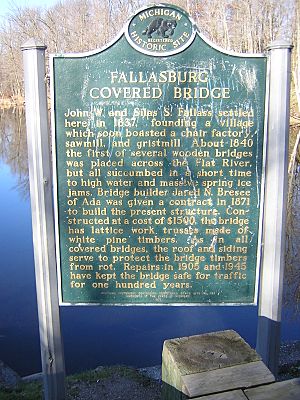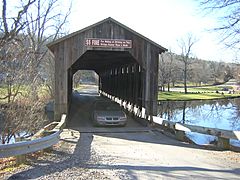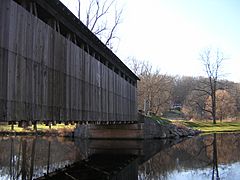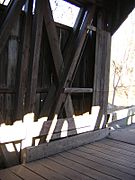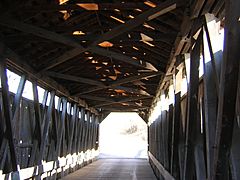Fallasburg Bridge facts for kids
Quick facts for kids Fallasburg Bridge |
|
|---|---|
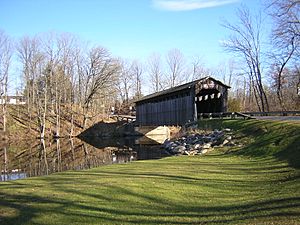
East Approach
|
|
| Carries | Covered Bridge Road |
| Crosses | Flat River |
| Locale | Lowell, Michigan |
| Maintained by | Kent County Road Commission |
| Characteristics | |
| Design | Brown truss Covered bridge |
| Total length | 100 feet (30 m) |
| Longest span | 97.8 feet (29.8 m) |
| Load limit | 3 short tons (2.7 t) |
| History | |
| Opened | 1871 |
| Closed | in use |
| Statistics | |
| Toll | no |
|
Fallasburg Covered Bridge
|
|
| Nearest city | Lowell, Michigan |
| Built by | Jared N. Bresee |
| NRHP reference No. | 72000627 |
| Added to NRHP | March 16, 1972 |
The Fallasburg Bridge is a 100-foot (30 m) long covered bridge built in 1871. It is located in Vergennes Township, Michigan, about 5 miles (8 km) north of Lowell. The bridge carries Covered Bridge Road over the Flat River.
This historic bridge is part of the Fallasburg Historic District. It is also listed on the National Register of Historic Places. The Fallasburg Bridge is one of only four covered bridges in Michigan that cars can still drive across today.
Contents
How the Bridge Was Built
The Fallasburg Bridge uses a special design called the Brown truss system. This system was invented by Josiah Brown in 1857. A truss is a framework of beams that supports a bridge.
Brown Truss Design
The Brown truss uses diagonal wooden beams that criss-cross to form "X" shapes. These beams help the bridge stay strong. This design is similar to another one called the Howe truss. However, the Brown truss uses less wood and almost no iron, except for the bolts that connect the pieces.
This type of truss was popular in Michigan for a short time. Builders used it for at least four covered bridges in the state. Three of these bridges, including the Fallasburg Bridge, are still standing today.
Bridge Materials and Structure
The Fallasburg Bridge sits on strong foundations made of concrete and fieldstone. These were added in 1905 to make it more stable. Like most covered bridges, it has a roof and sides that protect the wooden parts from weather. The roof is covered with creosote shingles.
The bridge is made of white pine wood from Greenville. The wooden trusses are completely covered on the outside with rough pine boards. The bridge floor is 14 feet (4.3 m) wide and 100 feet (30 m) long. It has an inside height of 12 feet (3.7 m).
You can see warning signs at each end of the bridge. They say: "$5 fine for riding or driving on this bridge faster than a walk."
History of the Fallasburg Bridge
The area around the Flat River was settled in 1837 by two brothers, John W. and Silas S. Fallas. They started a village there. It became a stop on the main travel route between Ionia and Grand Rapids. The brothers built a chair factory, a saw mill, and a grist mill (for grinding grain).
Earlier Bridges
The Fallasburg Bridge is not the first bridge built at this spot. Records show that a bridge was built here around 1840. But it was destroyed by ice jams and floods. It is believed that other bridges were also built and destroyed in similar ways before the current one.
In 1871, Jared N. Bresee was hired to build the bridge we see today. He also built the Ada Covered Bridge nearby. The Fallasburg Bridge cost $1500 to build.
Repairs and Preservation
Over the years, the bridge has been repaired and made stronger. The original foundations were replaced with concrete in 1905. There were also big repair projects in 1945 and 1994. Because these repairs were done carefully, the bridge still looks and feels like it did long ago.
The area around the bridge is now known as the Fallasburg Pioneer Village. It is next to Fallasburg Park. The bridge is seen as a "gateway to a place that time forgot."
Historical Recognition
The Fallasburg Covered Bridge was added to the Michigan State Register on February 12, 1959. It received a Michigan Historical Marker on September 10, 1971. Then, it was listed on the National Register of Historic Places on March 16, 1972. The bridge is also part of the Fallasburg Historic District, which was recognized as a historic district on March 31, 1999.
The historical marker at the bridge tells its story:
John W. and Silas S. Fallas settled here in 1837, founded a village which soon boasted a chair factory, sawmill, and gristmill. About 1840 the first of several wooden bridges was placed across the Flat River, but all succumbed in a short time to high water and massive spring ice jams. Bridge builder Jared N. Bresee of Ada was given a contract in 1871 to build the present structure. Constructed at a cost of $1500, the bridge has lattice work trusses made of white pine timbers. As in all covered bridges, the roof and siding serve to protect the bridge timbers from rot. Repairs in 1905 and 1945 have kept the bridge safe for traffic for one hundred years.
The Bridge Today
The Fallasburg Bridge is still open for cars to drive on. However, it has a weight limit of 3 tons (2.7 tonnes). In 2013, it was damaged when a heavy cement truck drove through it.
The bridge is a beautiful sight in Fallasburg Park. Its rural location and strong build helped it survive. Many old covered bridges were torn down to make way for new roads. But the Fallasburg Bridge remains, a reminder of the past.
Gallery




